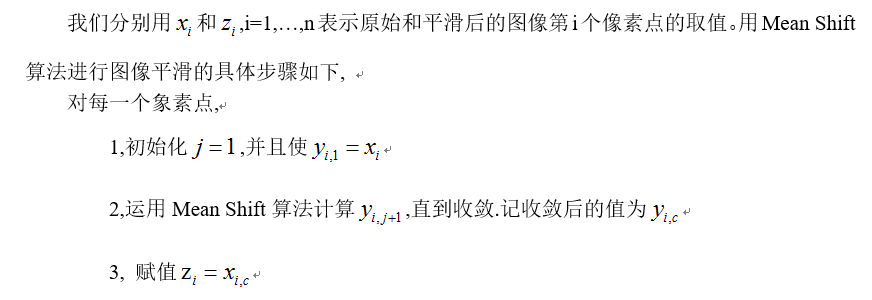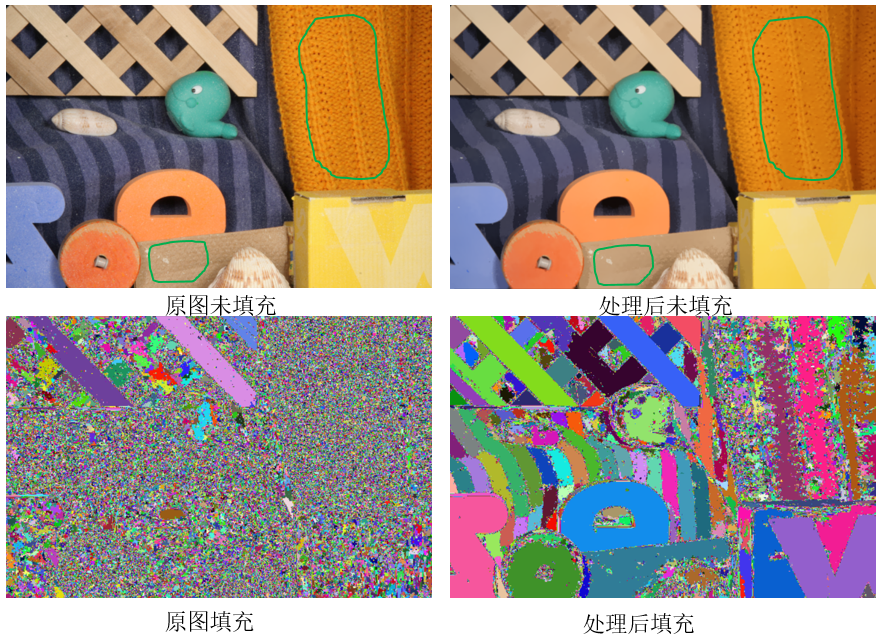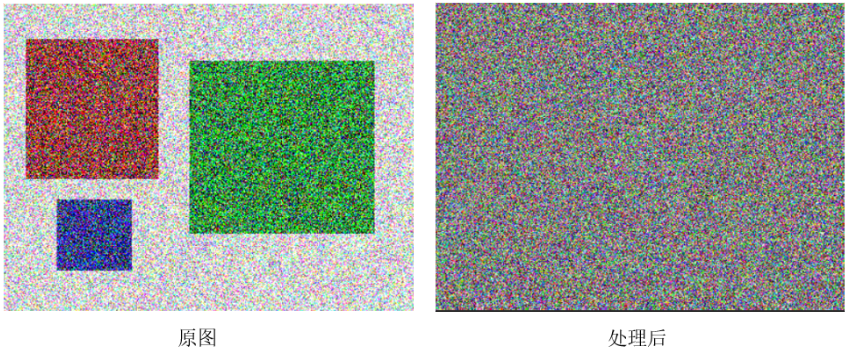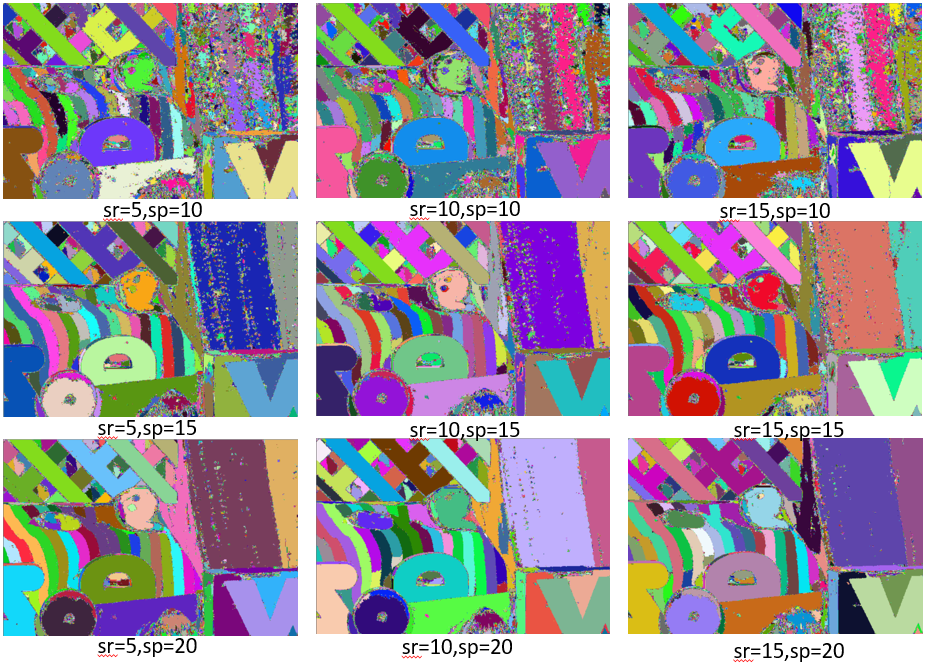學習OpenCV2——MeanShift之圖形分割
1. 原理
用meanshift做影象平滑和分割,其實是一回事。其本質是經過迭代,將收斂點的畫素值代替原來的畫素值,從而去除了區域性相似的紋理,同時保留了邊緣等差異較大的特徵。
OpenCV中自帶有基於meanshift的分割方法pyrMeanShiftFiltering()。由函式名pyrMeanShiftFiltering可知,這裡是將meanshift演算法和影象金字塔相結合用來分割的。
<span style="font-size:18px;">void PyrMeanShiftFiltering( const CvArr* srcarr, //輸入影象 CvArr* dstarr, //輸出影象 double sp, //顏色域半徑 double sr, //空間域半徑 int max_level, //金字塔最大層數 CvTermCriteria termcrit ) //迭代終止條件</span>
要求輸入和輸出影象都是CV_8UC3型別,而且兩者尺寸一樣。實際上並不需要去先定義dstarr,因為程式裡會將srcarr的格式賦值給dstarr。
termcrit有三種情況,迭代次數、迭代精度和兩者同時滿足。預設為迭代次數為5同時迭代精度為1。termcrit是個結構體,其結構如下
使用pyrMeanShiftFiltering()進行影象分割非常簡單,只需要定義sp0,sr,max_level和termrit,然後呼叫pyrMeanShiftFiltering()就行了。<span style="font-size:18px;">typedef struct CvTermCriteria { int type; /*CV_TERMCRIT_ITER或CV_TERMCRIT_EPS 或二者都是*/ int max_iter; /* 最大迭代次數 */ double epsilon; /* 結果的精確性 */ } CvTermCriteria;</span>
在實際操作時,為了使分割的結果顯示得更明顯,經常用floodFill( )將不同連通域塗上不同的顏色。具體情況參看下 面的例項。
2. 程式例項
來看看OpenCV自帶的一個用meanshift進行分割的例子
原程式見
“ .\OpenCV249\sources\samples\cpp\meanshift_segmentation.cpp”
程式很簡單,來看看floodFill()函式,有兩種形式<span style="font-size:18px;">#include "opencv2/highgui/highgui.hpp" #include "opencv2/core/core.hpp" #include "opencv2/imgproc/imgproc.hpp" #include <iostream> using namespace cv; using namespace std; static void help(char** argv) { cout << "\nDemonstrate mean-shift based color segmentation in spatial pyramid.\n" << "Call:\n " << argv[0] << " image\n" << "This program allows you to set the spatial and color radius\n" << "of the mean shift window as well as the number of pyramid reduction levels explored\n" << endl; } //This colors the segmentations static void floodFillPostprocess( Mat& img, const Scalar& colorDiff=Scalar::all(1) ) { CV_Assert( !img.empty() ); RNG rng = theRNG(); Mat mask( img.rows+2, img.cols+2, CV_8UC1, Scalar::all(0) ); for( int y = 0; y < img.rows; y++ ) { for( int x = 0; x < img.cols; x++ ) { if( mask.at<uchar>(y+1, x+1) == 0 ) { Scalar newVal( rng(256), rng(256), rng(256) ); floodFill( img, mask, Point(x,y), newVal, 0, colorDiff, colorDiff ); } } } } string winName = "meanshift"; int spatialRad, colorRad, maxPyrLevel; Mat img, res; static void meanShiftSegmentation( int, void* ) { cout << "spatialRad=" << spatialRad << "; " << "colorRad=" << colorRad << "; " << "maxPyrLevel=" << maxPyrLevel << endl; pyrMeanShiftFiltering( img, res, spatialRad, colorRad, maxPyrLevel ); //Mat imgGray; //cvtColor(res,imgGray,CV_RGB2GRAY); //imshow("res",res); floodFillPostprocess( res, Scalar::all(2) ); imshow( winName, res ); } int main(int argc, char** argv) { img = imread("rubberwhale1.png"); //img = imread("pic2.png"); if( img.empty() ) return -1; spatialRad = 10; colorRad = 10; maxPyrLevel = 1; namedWindow( winName, WINDOW_AUTOSIZE ); //imshow("img",img); createTrackbar( "spatialRad", winName, &spatialRad, 80, meanShiftSegmentation ); createTrackbar( "colorRad", winName, &colorRad, 60, meanShiftSegmentation ); createTrackbar( "maxPyrLevel", winName, &maxPyrLevel, 5, meanShiftSegmentation ); meanShiftSegmentation(0, 0); //floodFillPostprocess( img, Scalar::all(2) ); //imshow("img2",img); waitKey(); return 0; }</span>
int floodFill( InputOutputArray image, Point seedPoint, Scalar newVal, CV_OUT Rect* rect=0, Scalar loDiff=Scalar(), Scalar upDiff=Scalar(), int flags=4 );
int floodFill( InputOutputArray image, InputOutputArray mask, Point seedPoint, Scalar newVal, CV_OUT Rect* rect=0, Scalar loDiff=Scalar(), Scalar upDiff=Scalar(), int flags=4 );
InputOutputArray image 輸入輸出影象,要求格式為1通道或3通道,8位或浮點
InputOutputArray mask 掩膜,比image的寬和高各大兩畫素點
Point seedPoint 填充的起始點
Scalar newVal 畫素點被染色的值
CV_OUT Rect* rect=0 可選引數,設定floodFill()要重繪區域的最小邊界矩形區域
Scalar loDiff=Scalar() 定義當前畫素值與起始點畫素值的亮度或顏色負差的最大值
Scalar upDiff=Scalar() 定義當前畫素值與起始點畫素值的亮度或顏色正差的最大值
flags 操作標誌符
程式結果
處理後一些細小的紋理都平滑掉了,例如圖中綠色線條所指示的區域。未填充時,很多地方看得並不明顯,填充後就能明顯看出差別來了。填充後的圖很好地體現了meanshift聚類的思想!
再來看一組更“誇張”的效果圖
使用meanshift方法進行處理後,原來的三個矩形區域消失了!平滑掉了!
meanshift演算法的兩個關鍵引數是空間域半徑sr和顏色域半徑sp,別說max_level,那是構建影象金字塔的引數好吧。最後,我們來看看sr和sp對結果的影響。
顯然顏色域半徑sp對結果的影響比空間域半徑sr對結果的影響大。sp和sr越小,細節保留得越多,sp和sr越大,平滑力度越大。邊緣和顏色突變的區域的特徵保留的較好。因為meanshift要對每個畫素點進行操作,所以演算法的時間花銷很大。
3. 深入程式碼
<span style="font-size:14px;">/****************************************************************************************\
* Meanshift *
\****************************************************************************************/
CV_IMPL void
cvPyrMeanShiftFiltering( const CvArr* srcarr, CvArr* dstarr,
double sp0, double sr, int max_level,
CvTermCriteria termcrit )
{
const int cn = 3;
const int MAX_LEVELS = 8;
if( (unsigned)max_level > (unsigned)MAX_LEVELS )
CV_Error( CV_StsOutOfRange, "The number of pyramid levels is too large or negative" ); //限定max_level不超過8
std::vector<cv::Mat> src_pyramid(max_level+1); //+1是因為原始圖和最終圖都定義為影象金字塔的第0層
std::vector<cv::Mat> dst_pyramid(max_level+1);
cv::Mat mask0;
int i, j, level;
//uchar* submask = 0;
#define cdiff(ofs0) (tab[c0-dptr[ofs0]+255] + \
tab[c1-dptr[(ofs0)+1]+255] + tab[c2-dptr[(ofs0)+2]+255] >= isr22)
double sr2 = sr * sr;
int isr2 = cvRound(sr2), isr22 = MAX(isr2,16);
int tab[768];
cv::Mat src0 = cv::cvarrToMat(srcarr); //arr轉Mat
cv::Mat dst0 = cv::cvarrToMat(dstarr);
//確保src和dst都是CV_8UC3,且同尺寸
if( src0.type() != CV_8UC3 )
CV_Error( CV_StsUnsupportedFormat, "Only 8-bit, 3-channel images are supported" );
if( src0.type() != dst0.type() )
CV_Error( CV_StsUnmatchedFormats, "The input and output images must have the same type" );
if( src0.size() != dst0.size() )
CV_Error( CV_StsUnmatchedSizes, "The input and output images must have the same size" );
//確保迭代次數在1到100次,預設則為5;迭代精度預設為1.
if( !(termcrit.type & CV_TERMCRIT_ITER) )
termcrit.max_iter = 5;
termcrit.max_iter = MAX(termcrit.max_iter,1);
termcrit.max_iter = MIN(termcrit.max_iter,100);
if( !(termcrit.type & CV_TERMCRIT_EPS) )
termcrit.epsilon = 1.f;
termcrit.epsilon = MAX(termcrit.epsilon, 0.f);
for( i = 0; i < 768; i++ )
tab[i] = (i - 255)*(i - 255); //tab[]存的是(-255)^2到512^2
// 1. 構造金字塔
src_pyramid[0] = src0;
dst_pyramid[0] = dst0;
for( level = 1; level <= max_level; level++ )
{
//src_pyramid和dst_pyramid尺寸一樣,下一層是上一層尺寸的一半
src_pyramid[level].create( (src_pyramid[level-1].rows+1)/2,
(src_pyramid[level-1].cols+1)/2, src_pyramid[level-1].type() );
dst_pyramid[level].create( src_pyramid[level].rows,
src_pyramid[level].cols, src_pyramid[level].type() );
//對src_pyramid[level-1]下采樣,結果存入src_pyramid[level]
cv::pyrDown( src_pyramid[level-1], src_pyramid[level], src_pyramid[level].size() );
//CV_CALL( cvResize( src_pyramid[level-1], src_pyramid[level], CV_INTER_AREA ));
}
mask0.create(src0.rows, src0.cols, CV_8UC1);
//CV_CALL( submask = (uchar*)cvAlloc( (sp+2)*(sp+2) ));
// 2. 從頂層(最小層)開始應用meanshift演算法。
for( level = max_level; level >= 0; level-- )
{
cv::Mat src = src_pyramid[level];
cv::Size size = src.size();
uchar* sptr = src.data; //sptr指向影象矩陣的起始地址,也就是第一行的起始地址
int sstep = (int)src.step; //sstep是影象矩陣每一行的長度(以位元組為單位),以便後面計算地址
uchar* mask = 0;
int mstep = 0;
uchar* dptr;
int dstep;
float sp = (float)(sp0 / (1 << level));
sp = MAX( sp, 1 ); //這裡保證了sp≥1,那麼視窗最小是3×3
//這段語句主要作用1、通過上取樣得到dst_pyramid[level];2、得到掩碼mask
if( level < max_level )
{
cv::Size size1 = dst_pyramid[level+1].size();
cv::Mat m( size.height, size.width, CV_8UC1, mask0.data );
dstep = (int)dst_pyramid[level+1].step;
dptr = dst_pyramid[level+1].data + dstep + cn;
mstep = (int)m.step;
mask = m.data + mstep;
//cvResize( dst_pyramid[level+1], dst_pyramid[level], CV_INTER_CUBIC );
cv::pyrUp( dst_pyramid[level+1], dst_pyramid[level], dst_pyramid[level].size() ); //上取樣
m.setTo(cv::Scalar::all(0));
for( i = 1; i < size1.height-1; i++, dptr += dstep - (size1.width-2)*3, mask += mstep*2 )
{
for( j = 1; j < size1.width-1; j++, dptr += cn )
{
int c0 = dptr[0], c1 = dptr[1], c2 = dptr[2];
mask[j*2 - 1] = cdiff(-3) || cdiff(3) || cdiff(-dstep-3) || cdiff(-dstep) ||
cdiff(-dstep+3) || cdiff(dstep-3) || cdiff(dstep) || cdiff(dstep+3);
}
}
cv::dilate( m, m, cv::Mat() ); //對m膨脹
mask = m.data;
}
dptr = dst_pyramid[level].data; //dptr指向影象矩陣起始地址
dstep = (int)dst_pyramid[level].step; //dstep表示影象矩陣每一行的佔記憶體的位元組數
for( i = 0; i < size.height; i++, sptr += sstep - size.width*3,
dptr += dstep - size.width*3, //每處理完一行,sptr和dptr都指向下一行的起始地址
mask += mstep )
{
for( j = 0; j < size.width; j++, sptr += 3, dptr += 3 ) //每處理完一列,sptr和dptr都指向同行下一列畫素的起始地址,所以sptr和dptr實際就是每個畫素點的地址
{
int x0 = j, y0 = i, x1, y1, iter;
int c0, c1, c2;
if( mask && !mask[j] )
continue;
c0 = sptr[0], c1 = sptr[1], c2 = sptr[2]; //分別對應畫素點三通道的地址
// iterate meanshift procedure
for( iter = 0; iter < termcrit.max_iter; iter++ )
{
uchar* ptr;
int x, y, count = 0;
int minx, miny, maxx, maxy;
int s0 = 0, s1 = 0, s2 = 0, sx = 0, sy = 0; //(x,y)的迭代的座標值,(s0,s1,s2)是迭代的3通道分量值
double icount;
int stop_flag;
//mean shift: process pixels in window (p-sigmaSp)x(p+sigmaSp)
minx = cvRound(x0 - sp); minx = MAX(minx, 0); //若j-sp>=0,則minx=(j-sp),否則,minx=0;
miny = cvRound(y0 - sp); miny = MAX(miny, 0); //若i-sp>=0,則miny=(i-sp),否則,miny=0;
maxx = cvRound(x0 + sp); maxx = MIN(maxx, size.width-1); //若j+sp<=width+1,則maxx=j+sp,否則,maxx=width-1;
maxy = cvRound(y0 + sp); maxy = MIN(maxy, size.height-1); //若i+sp<=height+1,則maxy=i+sp,否則,maxy=height-1;
ptr = sptr + (miny - i)*sstep + (minx - j)*3; //sptr指向(i,j),ptr則指向當前視窗第一個畫素點
for( y = miny; y <= maxy; y++, ptr += sstep - (maxx-minx+1)*3 ) //視窗內,每處理完一行,ptr指向下一行首地址
{
int row_count = 0;
x = minx;
#if CV_ENABLE_UNROLLED
for( ; x + 3 <= maxx; x += 4, ptr += 12 ) //這兩次for迴圈是什麼意思?顏色限定和空間限定?
{
int t0 = ptr[0], t1 = ptr[1], t2 = ptr[2];
if( tab[t0-c0+255] + tab[t1-c1+255] + tab[t2-c2+255] <= isr2 )
{
s0 += t0; s1 += t1; s2 += t2;
sx += x; row_count++;
}
t0 = ptr[3], t1 = ptr[4], t2 = ptr[5];
if( tab[t0-c0+255] + tab[t1-c1+255] + tab[t2-c2+255] <= isr2 )
{
s0 += t0; s1 += t1; s2 += t2;
sx += x+1; row_count++;
}
t0 = ptr[6], t1 = ptr[7], t2 = ptr[8];
if( tab[t0-c0+255] + tab[t1-c1+255] + tab[t2-c2+255] <= isr2 )
{
s0 += t0; s1 += t1; s2 += t2;
sx += x+2; row_count++;
}
t0 = ptr[9], t1 = ptr[10], t2 = ptr[11];
if( tab[t0-c0+255] + tab[t1-c1+255] + tab[t2-c2+255] <= isr2 )
{
s0 += t0; s1 += t1; s2 += t2;
sx += x+3; row_count++;
}
}
#endif
for( ; x <= maxx; x++, ptr += 3 )
{
int t0 = ptr[0], t1 = ptr[1], t2 = ptr[2];
if( tab[t0-c0+255] + tab[t1-c1+255] + tab[t2-c2+255] <= isr2 )
{
s0 += t0; s1 += t1; s2 += t2;
sx += x; row_count++;
}
}
count += row_count;
sy += y*row_count;
}
if( count == 0 )
break;
icount = 1./count;
x1 = cvRound(sx*icount);
y1 = cvRound(sy*icount);
s0 = cvRound(s0*icount);
s1 = cvRound(s1*icount);
s2 = cvRound(s2*icount);
stop_flag = (x0 == x1 && y0 == y1) || abs(x1-x0) + abs(y1-y0) +
tab[s0 - c0 + 255] + tab[s1 - c1 + 255] +
tab[s2 - c2 + 255] <= termcrit.epsilon;
x0 = x1; y0 = y1;
c0 = s0; c1 = s1; c2 = s2;
if( stop_flag )
break;
}
dptr[0] = (uchar)c0;
dptr[1] = (uchar)c1;
dptr[2] = (uchar)c2;
}
}
}
}
void cv::pyrMeanShiftFiltering( InputArray _src, OutputArray _dst,
double sp, double sr, int maxLevel,
TermCriteria termcrit )
{
Mat src = _src.getMat();
if( src.empty() )
return;
_dst.create( src.size(), src.type() );
CvMat c_src = src, c_dst = _dst.getMat();
cvPyrMeanShiftFiltering( &c_src, &c_dst, sp, sr, maxLevel, termcrit );
}</span><span style="font-size:18px;">
</span>



